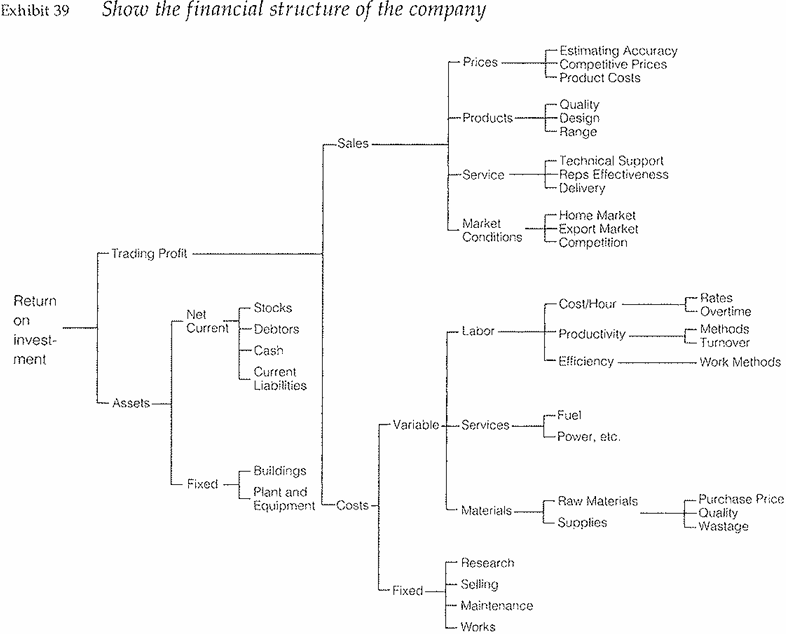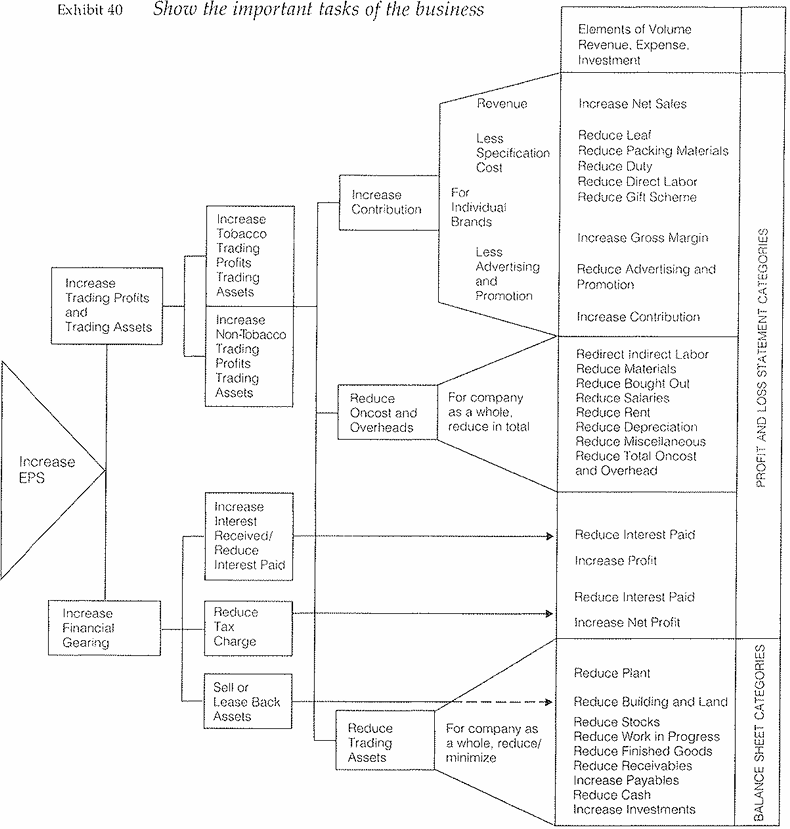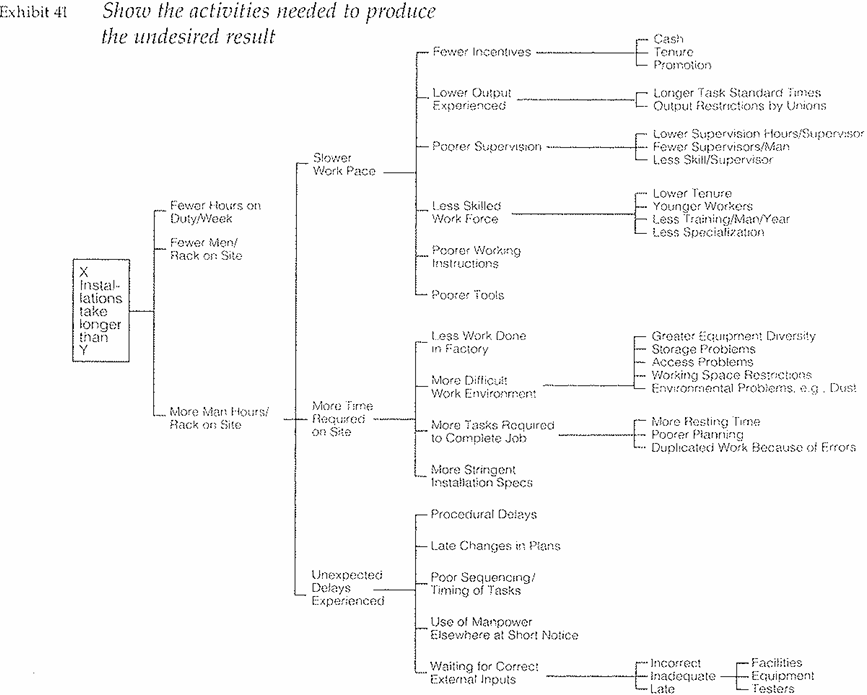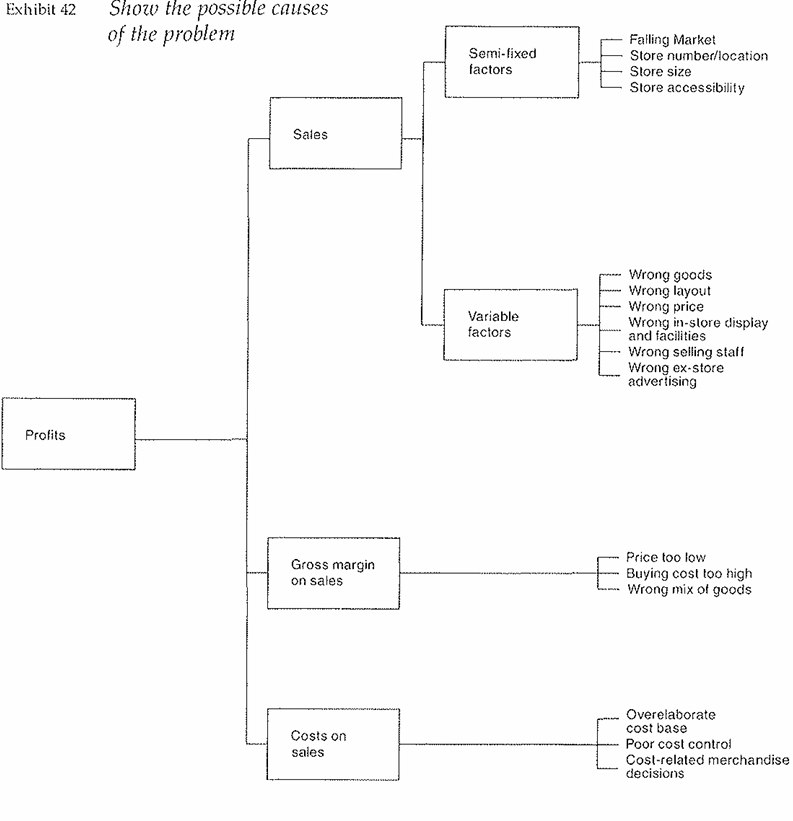


 Grammar
Grammar
 Tenses
Tenses
 Present
Present
 Past
Past
 Future
Future
 Parts Of Speech
Parts Of Speech
 Nouns
Nouns
 Verbs
Verbs
 Adverbs
Adverbs
 Adjectives
Adjectives
 Pronouns
Pronouns
 Pre Position
Pre Position
 Preposition by function
Preposition by function 
 Preposition by construction
Preposition by construction
 Conjunctions
Conjunctions
 Interjections
Interjections
 Grammar Rules
Grammar Rules
 Linguistics
Linguistics
 Semantics
Semantics
 Pragmatics
Pragmatics
 Reading Comprehension
Reading Comprehension|
Read More
Date: 2024-09-26
Date: 2024-09-18
Date: 2024-09-12
|
The second way to diagnose a problem is to trace the cause-effect elements, activities, or tasks that go to make up a particular end result. You can do this by showing levels of financial elements, tasks, or activities.
1. Financial Structure. You would use this approach if you wanted to show the financial structure of a company, say to identify the reasons for the R1 low return on investment (Exhibit 39).

Putting numbers on the chart, you would be able to judge very quickly whether the problem stems from the fact that Sales are low compared to last year, or Costs are high, or both. Accordingly, you would break down each element to show its key influences, and then identify the components of each influence (e.g., for Sales, product volume is dictated by the quality of the product, the design, and the range offered). Once the structure is complete, you would seek to determine, "Is the problem in the product volume? Is it in the pricing?" etc, and think through the data you would need to answer each question yes or no.
2. Task Structure. A deeper, more explicit approach is to make the tree show the important tasks of the business that it must organize itself to perform (Exhibit 40). To do so you begin with EPS (earnings per share) and divide the tree in terms of the company's financial structure, stating each element as a discrete managerial task. Then you impose the Profit and Loss Accom and the Balance Sheet on this structure, again stating each item as a task. This approach has the great advantage of identifying the kind of action required should the problem be found at this point.

Contribution in a cigarette company, for example, is composed of Revenue minus Specification Costs (leaf, packing materials, duty, direct labor), minus Advertising and Promotion. These categories then become tasks (Increase Net Sales, Reduce Leaf Costs, etc.). You now know the key tasks of the business, and can analyze the numbers in the tree (trends, sensitivities, comparisons to industry and competition) to determine the priorities for performing them to increase EPS.
3. Activity Structure. Another approach is to use a tree to trace the activities that have to be performed to produce an undesirable end objective-high costs, for example, or overlong installation times (Exhibit 41). The trick here is to visualize all the causes that could possibly bring about the effect, and relate them at their proper levels.
For example, installation of telephone switching equipment involves work partly done in the contractor's factory and partly done by his men on the site. Elements at the site are the men doing the building, the facilities available to them, the equipment being installed, the testers testing the equipment, and the customer approving the procedure at various intervals. How do these all relate?

As you can see from Exhibit 41, you begin your tree with the undesirable effect you are trying to understand, that installations take longer than expected. At the next level you hypothesize the mutually exclusive and collectively exhaustive reasons that this result could occur: fewer men on each rack, more hours per man on each rack, fewer hours on duty per week.
You then take each possible reason and break it down further. What could cause more hours per man on each rack? Either the men are working more slowly, or the job itself demands more time, or there are unexpected delays. Again, you take each possibility and ask, why would this happen? The result is a complete list of the areas where facts could be gathered and analyzed. Your experience in the industry will tell you where to look first.

|
|
|
|
دخلت غرفة فنسيت ماذا تريد من داخلها.. خبير يفسر الحالة
|
|
|
|
|
|
|
ثورة طبية.. ابتكار أصغر جهاز لتنظيم ضربات القلب في العالم
|
|
|
|
|
|
|
سماحة السيد الصافي يؤكد ضرورة تعريف المجتمعات بأهمية مبادئ أهل البيت (عليهم السلام) في إيجاد حلول للمشاكل الاجتماعية
|
|
|